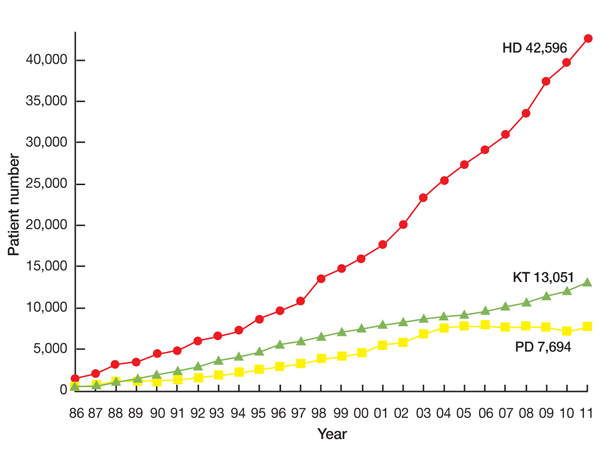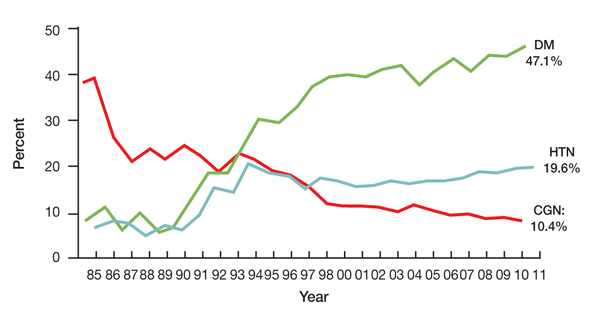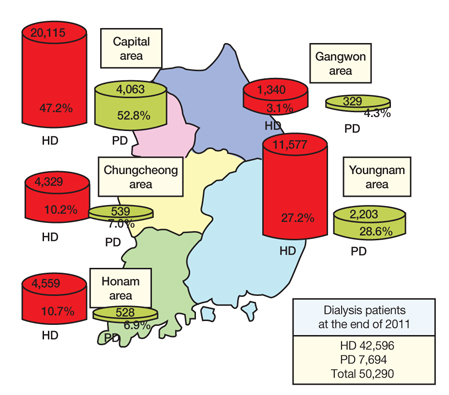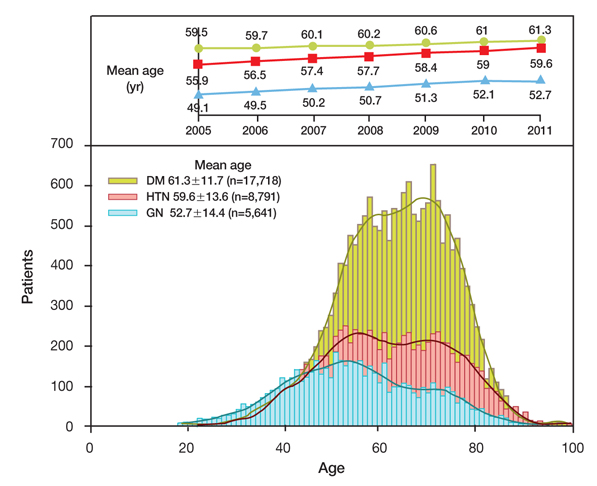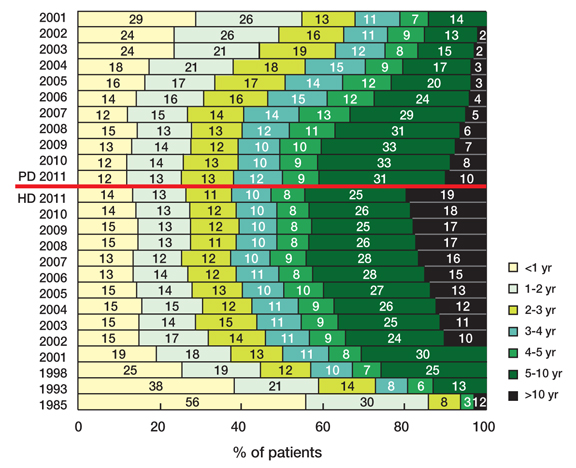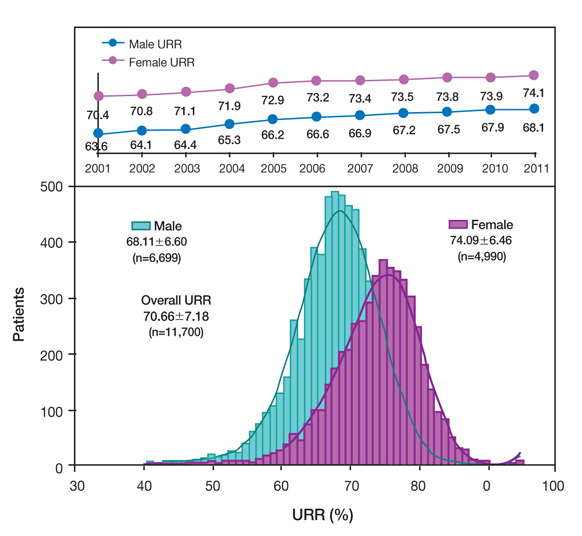Current status of dialysis therapy for ESRD patients in Korea
- Affiliations
-
- 1Department of Internal Medicine, The Catholic University of Korea College of Medicine, Seoul, Korea. jindongc@catholic.ac.kr
- 2ESRD Registry Committee, Korean Society of Nephrology, Seoul, Korea.
- KMID: 2193045
- DOI: http://doi.org/10.5124/jkma.2013.56.7.562
Abstract
- The Korean Society of Nephrology (KSN) launched the End-Stage Renal Disease (ESRD) Patient Registry in 1985, and the online internet registry program was begun in 2001. The increasing number of elderly people and diabetic patients in Korea has resulted in a very rapid increase in the number of ESRD patients. The total number of dialysis patients was 50,289: 42,596 receiving hemodialysis (HD) and 7,694 receiving peritoneal dialysis (PD) at the end of 2011. The prevalence of dialysis therapy was 972.4 patients per million population (PMP), and the proportion of dialysis therapy was HD: 84.7% and PD: 15.3%. The primary causes of ESRD were diabetic nephropathy (47.1%), hypertensive nephrosclerosis (19.6%), and chronic glomerulonephritis (10.4%). The mean urea reduction ratio of hemodialysis was 68.11% in male HD patients and 74.09% in female HD patients. The mean Kt/V was 1.395 in male patients and 1.660 in female patients. The most common cause of death was cardiac arrest (26%), followed by sepsis (9.7%), cerebro-vascular accident (8.7%), respiratory infection (8.4%), and myocardial infarction (6.6%), respectively. The five-year survival rates of male and female dialysis patients were 65.3% and 68.0% in Korea.
MeSH Terms
Figure
Cited by 7 articles
-
Nutritional Status and Dietary Management According to Hemodialysis Duration
Hee-Sook Lim, Hee-Seon Kim, Jin Kuk Kim, Mooyong Park, Soo Jeong Choi
Clin Nutr Res. 2019;8(1):28-35. doi: 10.7762/cnr.2019.8.1.28.Quality of Life among End-stage Renal Disease Treatments and Economic Evaluation of Renal Transplantation and Hemodialysis Treatments
Kyung-Ock Jeon, Sun-Young Son, Myung-Il Hahm, Soon-Il Kim
J Korean Soc Transplant. 2015;29(4):200-208. doi: 10.4285/jkstn.2015.29.4.200.The Long-term Outcomes of Kidney Transplantation from Donation after Circulatory Death during Brain Death Donor Evaluation in a Single Center in Korea
Nayoon Hur, Hyojun Park, Kyowon Lee, Gyuseong Choi, Jong Man Kim, Jae Berm Park, Choon Hyuck Kwon, Sung Joo Kim, Jae-Won Joh, Suk-Koo Lee
J Korean Soc Transplant. 2015;29(4):216-226. doi: 10.4285/jkstn.2015.29.4.216.Effect of Simultaneous Nephrectomy on Perioperative Blood Pressure and Graft Outcome in Renal Transplant Recipients with Autosomal Dominant Polycystic Kidney Disease
Hyung Ah Jo, Hayne Cho Park, Hyunsuk Kim, Miyeun Han, Jong Cheol Jeong, Kook-Hwan Oh, Jaeseok Yang, Hee Jung Jeon, Tai Yeon Koo, Jongwon Ha, Cheol Kwak, Young-Hwan Hwang, Curie Ahn
J Korean Soc Transplant. 2016;30(1):24-30. doi: 10.4285/jkstn.2016.30.1.24.Effects of Intra-dialytic, Short-term Resistance Exercise on Physical Fitness, Depression and Dialysis Adequacy
On Lee, Myoung-Hyee Kim, Chang-Hwa Lee, Il-Hwan Oh, Yeon-Soo Kim
Korean J Sports Med. 2016;34(2):162-168. doi: 10.5763/kjsm.2016.34.2.162.Factors Influencing Medication Adherence in Hemodialysis Patients: Focusing on Primary and Secondary Medical Care
Yon Hee Seo, Sun Og Lim, Eun Hee Hyeon, Hae Won Kim, Mi Ran Eom
Perspect Nurs Sci. 2015;12(1):60-70. doi: 10.16952/pns.2015.12.1.60.Factors Affecting Malnutrition in Hemodialysis Patients
Ok Lae Park, Young Jun Jang, Jong Hwan Jung, Sung Reul Kim
Korean J Adult Nurs. 2016;28(2):226-236. doi: 10.7469/kjan.2016.28.2.226.
Reference
-
1. ESRD Registry Committee, Korean Society of Nephrology. Current renal replacement therapy in Korea [Internet]. Seoul: Korean Society of Nephrology;cited 2013 Mar 12. Available from: http://www.ksn.or.kr.2. Jin DC, Ha IS, Kim NH, Lee SW, Lee JS, Yoon SR, Kim BS. Brief report: renal replacement therapy in Korea, 2010. Kidney Res Clin Pract. 2012; 31:62–71.
Article3. Jin DC. Current status of dialysis therapy in Korea. Korean J Intern Med. 2011; 26:123–131.
Article4. Yoon KY, Ahn MH, Moon BO, Kim CK, Lee SM, Whang WH, Lee TH. Use of artificial kidney in renal failure. Korean J Intern Med. 1967; 10:11–19.5. Min BS, Bang BK. Current state of dialysis therapy in Korea: at the end of December 31, 1980. Korean J Nephrol. 1982; 1:5–7.6. United States Renal Data System. 2012 Annual data report [Internet]. Minneapolis: United States Renal Data System;cited 2013 Mar 12. Available from: http://www.usrds.org/adr.htm.7. Japanese Society for Dialysis Therapy. An overview of regular dialysis treatment in Japan [Internet]. Tokyo: Japanese Society for Dialysis Therapy;cited 2013 Mar 12. Available from: http://www.jsdt.or.jp/Overview_2.html.8. European Renal Association. European Renal Association-European Dialysis and Transplantation Association Registry annual report 2010 [Internet]. Amsterdam: European Renal Association;2012. cited 2013 Mar 12. Available from: http://www.era-edta-reg.org/index.jsp.

